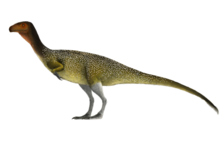Chilesaurus
[2] Showing a combination of traits from theropods, ornithischians, and sauropodomorphs, this genus has far-reaching implications for the evolution of dinosaurs, such as whether the traditional saurischian-ornithischian split is superior or inferior to the proposed group Ornithoscelida.
He and his parents, the geologists Manuel Suárez and Rita de la Cruz, were searching for decorative stones in the Aysén Region, and uncovered a vertebra and rib from what would later be named Chilesaurus.
[6] One reason this realization took time was that Chilesaurus has such a bizarre combination of traits, coupled with the fact that the remains were discovered alongsife a few bones from an unrelated diplodocid sauropod.
[7] In 2015, the type species C. diegosuarezi was named and described by Fernando Emilio Novas, Leonardo Salgado, Manuel Suárez, Federico Lisandro Agnolín, Martín Dario Ezcurra, Nicolás Chimento, Rita de la Cruz, Marcelo Pablo Isasi, Alexander Omar Vargas, and David Rubilar-Rogers.
The generic name is derived from Chile (the country where it was discovered) and the latinized Greek suffix "saurus", meaning "lizard".
The publication in which this was proposed also resurrected the previously-discredited "Ornithoscelida hypothesis", which suggested that theropods shared a more recent common ancestor with ornithischians than with sauropodomorphs.
[8][9] Less than a year later in 2018, Müller and colleagues published a reply to Baron & Barrett (2017), arguing that their phylogenetic dataset actually suggested that Chilesaurus was a basal sauropodomorph rather than an ornithischian.
[10][3] However, Müller and colleagues also noted that Baron and Barrett did not test the original proposal of Chilesaurus as a theropod, and that its classification remained uncertain.
[5] A full osteological description of Chilesaurus was published as part of the PhD thesis of Nicolás Roberto Chimento Ortiz in 2018.


